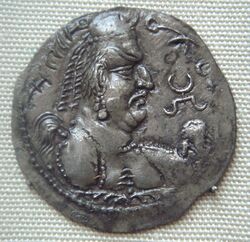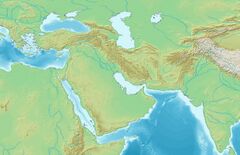Place:Khingila I
| Khingila I | |
|---|---|
| Ruler of the Alchon Huns | |
 | |
| Reign | 430-490 |
| Successor | Mehama |
| Born | c. 430 Central Asia |
| Died | c. 490 (aged 59–60) |
Khingila I (Bactrian: ![]() χιγγιλο Khingilo, Brahmi script:47px Khi-ṇgi-la, Middle Chinese: 金吉剌 Jīnjílà, Persian: شنگل Shengel; c.430-490) was the founding king of the Hunnic Alkhan dynasty (Bactrian: αλχανο, Middle Chinese: 嚈噠). He was a contemporary of Khushnavaz (fl. 484).
χιγγιλο Khingilo, Brahmi script:47px Khi-ṇgi-la, Middle Chinese: 金吉剌 Jīnjílà, Persian: شنگل Shengel; c.430-490) was the founding king of the Hunnic Alkhan dynasty (Bactrian: αλχανο, Middle Chinese: 嚈噠). He was a contemporary of Khushnavaz (fl. 484).
Rule
In response to the migration of the Wusun (who were hard-pressed by the Rouran) from Zhetysu to the Pamir region, Khingila united the Uars and the Xionites in 460AD, establishing the Hepthalite dynasty.
According to the Syrian compilation of Church Historian Zacharias Rhetor (c. 465, Gaza – after 536), bishop of Mytilene, the need for new grazing land to replace that lost to the Wusun led Khingila's "Uar-Chionites" to displace the Sabirs to the west, who in turn displaced the Saragur, Ugor and Onogur, who then asked for an alliance and land from Byzantium.[citation needed]
In his coin in the Brahmi script, Khingila uses the legend "God-King Khingila" (![]() 12px14px18px
12px14px18px![]() , Deva Shahi Khingila).[3]
, Deva Shahi Khingila).[3]
A "Seal of Khingila" is known, with legend in the Bactrian language, but it is uncertain if it belonged to Khingila, or another ruler of the same name.[4]
Khingila is also known from a Brahmi inscription, the Talagan copper scroll.
Artifacts
-
Coin of younger Khingila, circa 440-490 CE.[5]
-
Later coinage, with name "Khingila" in the Brahmi script.
-
A coin of Khingila with the title Deva Shahi Khinghila (
 10px14px16px
10px14px16px "God-King Khingila"), 440-490 CE.[3]
"God-King Khingila"), 440-490 CE.[3] -
The word "Alchono" (αλχοννο) in the Greco-Bactrian cursive script, on a coin of Khingila.[8]
-
Alchon horseman, possibly Khingila, on the Hephthalite silver bowl.[9]
-
"Khingila" in Brahmi script on his later coinage
See also
References
- ↑ This coin is in the collection of the British Museum. For equivalent coin, see CNG Coins
- ↑ Rezakhani, Khodadad (2017) (in en). ReOrienting the Sasanians: East Iran in Late Antiquity. Edinburgh University Press. pp. 105–124. ISBN 9781474400305. https://books.google.com/books?id=bjRWDwAAQBAJ&pg=PA105.
- ↑ 3.0 3.1 Dhavalikar, M. K. (1971). "A Note on Two Gaṇeśa Statues from Afghanistan". East and West 21 (3/4): 331–336. ISSN 0012-8376. https://www.jstor.org/stable/pdf/29755703.pdf.
- ↑ ALRAM, MICHAEL (2003). "Three Hunnic Bullae from Northwest India". Bulletin of the Asia Institute 17: 180, Figure 11. ISSN 0890-4464. https://www.jstor.org/stable/pdf/24049314.pdf.
- ↑ CNG coins
- ↑ Rezakhani, Khodadad (2017) (in en). ReOrienting the Sasanians: East Iran in Late Antiquity. Edinburgh University Press. p. 199. ISBN 9781474400312. https://books.google.com/books?id=VjVYDwAAQBAJ&pg=PT199.
- ↑ CNG Coins
- ↑ CNG Coins
- ↑ Bakker, Hans T. (12 March 2020) (in en). The Alkhan: A Hunnic People in South Asia. Barkhuis. pp. 43–47. ISBN 978-94-93194-00-7. https://books.google.com/books?id=ZLnVDwAAQBAJ&pg=PA43.
External links
| Preceded by Anonymous |
King of the Alchon Huns 430-461 |
Succeeded by Mehama |
 |

![Coin of younger Khingila, circa 440-490 CE.[5]](/wiki/images/thumb/6/6d/Khingila_of_the_Alchon_Huns_Circa_440-490_CE.jpg/200px-Khingila_of_the_Alchon_Huns_Circa_440-490_CE.jpg)
![Khingila with the word "Alchono" in Bactrian script (αλχονο) and the Tamgha symbol on his coins.[6][7]](/wiki/images/thumb/8/8d/Khingila_Alchono.jpg/200px-Khingila_Alchono.jpg)

![A coin of Khingila with the title Deva Shahi Khinghila (10px14px16px "God-King Khingila"), 440-490 CE.[3]](/wiki/images/thumb/6/65/Devashahi_Khingila.jpg/102px-Devashahi_Khingila.jpg)
![The word "Alchono" (αλχοννο) in the Greco-Bactrian cursive script, on a coin of Khingila.[8]](/wiki/images/thumb/4/44/Alchono_legend_with_coin.jpg/200px-Alchono_legend_with_coin.jpg)
![Alchon horseman, possibly Khingila, on the Hephthalite silver bowl.[9]](/wiki/images/thumb/3/3b/Hephthalite_horseman_on_British_Museum_bowl_460-479_CE.jpg/122px-Hephthalite_horseman_on_British_Museum_bowl_460-479_CE.jpg)

